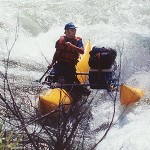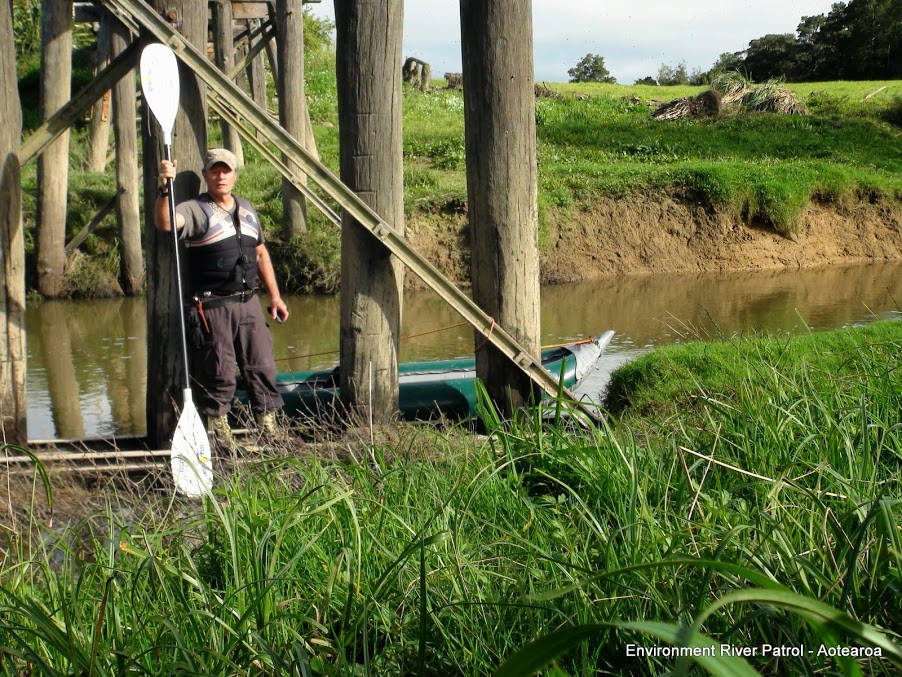Comments Reviews on theboatpeople.com Raft Cataraft Inflatable Kayak Products and Service › Forums › New Zealand Environment River Patrol by Millan Ruka › NRC Report # 099 Survey – Waiotu, Whakapara & upper Wairua River New Zealand
- This topic has 0 replies, 1 voice, and was last updated 11 years ago by
 Lee Arbach TBP.
Lee Arbach TBP.
-
AuthorPosts
-
November 4, 2014 at 4:31 am #2110
 Lee Arbach TBPKeymaster
Lee Arbach TBPKeymaster
1
03.11.2014 To
Whangarei District Council, Northland Regional Council, FNDC, Fonterra, Federated Farmers, Hapuu, IKHMG and stake holders –
Re: Report# 099 – Survey of Waiotu River, Whakapara River and upper Wairua River of the Hikurangi Swamp catchment.
This report #099 relates to a paddle patrol on the Waiotu River 29.09.2014 and several other patrols by motor boat, kayak, and foot over 2011, 2012, 2013, 2014. All of the photos taken on Waiotu, Whakapara and Wairua Rivers past and present are of areas where detrimental effects continue from unfenced beef and dairy cattle on the riparian of these waterways. These three rivers all flow into the Northern Wairoa River and on down into the Kaipara Moana
01.03.2012 the Whangarei District Council amended the leases to require 12 farmer lease holders on the Hikurangi Swamp flood banks to fence off their cattle from the rivers, or remove them The photos in this report show that this practice continuous at many locations on the three rivers. While many locations have greatly improved with some fencing or less stock numbers, clearly these photos identify that some farmers have yet to meet their lease requirements some two and half years on. Others such as shown in Report #099 graze their dairy herds right on the edge of the river against a hot wire that serves no purpose to keep urine and excrement from entering the waterway. This same farm has a generous fenced riparian on the opposite side river bank, but dairy cows routinely are seen grazing on wrong side of the fence up to the waters edge without any hot wire fencing. This practice is now a very common trend where we see dairy and beef cattle on the water side of a fenced riparian.
Another farmer has dairy breeding stock herds on the Whakapara River on the right side just down river from the Whakapara River Bridge on State Highway 1. This location has been subject to several reports and yet the detrimental effects continuous. Report #004 11.07.2011 on this location is very disturbing to view. Still this farmer continuous to farm cattle unfenced on several klm of river bank.
Other locations subject to previous reports, are still allowing their cattle to have access to the rivers edge. In many instances cattle have no water troughs, or the troughs are in disrepair, so the cattle drink directly from the river and foul up-to and into the water with urine and excrement. Cattle on

the left side looking up river from the Whakapara River bridge on State Highway 1 are now back on the riparian and they are fouling at the waters edges.
WDC needs to take ownership of the problem and act on the breaches of the leased lands within its jurisdiction. It is a waste of ratepayer and taxpayers money to have environmental departments but take no action on obvious breaches of the RMA. The NRC also is not using the existing RMA and together both WDC and NRC are not dealing with the issues. It seems farcical that together they have vast environmental resource’s but are not attending to our waterways that pollute the Kaipara Harbour to a point where it is now deemed to be in crisis (ref Northern Advocate article 23rd June 2011).
Accumulative effects – These detrimental effects, some less, some more, and spaced apart, form “accumulative effects” ( AEs). When you add up all these AEs all over the hundreds of klm in the Wairua catchment, you get much heavier increase of sedimentation than would normally be caused naturally. With the sedimentation there is high urine and excrement in the mix as a lot of it is caused by unfenced beef cattle. Beef are not included to be fenced in the Sustainable Dairying: Water Accord 2013. Dairy effluent from inefficient effluent ponds and dairy herds grazing in small drains and streams also add greatly to “accumulative effects”. Sediment is clouding the waters of the Kaipara Harbour and stopping the sunlight that the sea grass depends on for its growth. Sea grass is an integral component of this great fish nursery for many fish species.
Regional Councils should engage river/stream patrol contractors same as parking wardens, noise control officers, fish and game wardens etc. Issue warnings, issue light fines, issue bigger fines for those that resist “good practice” fencing or allow irresponsible effluent discharges. Give our farmers a “fair go” and allow for phase in time that is practical, and compassionate to them and their incomes. Give tax relief and any other assistance that can be reasonably afforded. All farms should ultimately require a “Warrant of Fitness” with 3 yearly checks. There was a time when we gave little consideration to get some one to do our lawns some 25 years ago, now it’s a major business. Riparian fencing maintenance on waterways could be managed in the same manner by contractors, particularly after flood periods. It need not be a chore for farmers, it needs a new approach to solve what is an endemic problem that blights our farming industry and threatens our exports along with our clean green image. Fencing maintenance gangs could be supplied from forestry type contractors whom are used to casual labour and outdoors work. They could take care of fence construction, planting and maintenance as a “service industry” to our farming sector.
The dairy (&beef) industry self assess itself for fencing requirements and do not require its farmers to fence off (non accord) small streams and drains that are less than 30cm deep and 1 metre wide. These smaller waterways are the veins of the artery (our rivers). Beef farmers are not signatories of the Sustainable Dairying: Water Accord 2013. Unfenced beef cattle are a major cause of sedimentation and pollution of our waterways. In Northland we see a common situation where dairy cow herds in river and stream country are replaced with beef cattle or dairy breeding stock so as to not have to meet fencing requirements. These cattle are left for much longer periods and often are not moved at all from long stretches of riparian on our waterways.
2

Northland Regional Council, Whangarei District Council and Fonterra has $millions$ of GIS mapping resources. Yet there is no common fence mapping system between the three to show what is fenced, what is not etc. It is from a collaborative initiative that we would finally get some clarity and professionalism to assess and monitor our waterways. Fonterra currently have a comprehensive GIS fencing mapping system but will not share it with other stake holders or authorities despite the fact that the waterways are supposedly shared by all. They should demonstrate with open clarity on their progress, rather than just state that 95% is fenced in the country when in the North this is not situation that we see.
We need to quickly adopt new ways to meet our Fresh Water Management Policy aspirations. The main business taking place at present to meet FWMP by the industry is making applications for more water, increase discharges of effluent and to construct irrigation dams. The Government wants 40% growth in primary industries and dairy is expected to be a major part of this. Beef prices have risen (they say) up to 100% over the past 18 months. So we can anticipate that dairy farmers will up production to meet their forecast lower returns and beef to expand with the much improved prices. This will increase intensification of farming and is not a good for the future of water quality to our rivers and streams. PM John Key recently announced dairy farms must be fenced off by July 1st 2017. All good news but independent assessment is required and beef cattle need to be included.
This new era needs to be “balanced” with an independent method of river & stream patrol monitoring to meet the forecasted intensification and expansion of our dairy and beef cattle farming industry.
FNDC Parking and Traffic control bylaws = 11x pages WDC Parking and Traffic bylaws 2009 = 28x pages NRC bylaws on cattle grazing ( ie parking) unfenced on our water ways = zero pages *note – none of the above have any policy on cattle/cows polluting waterways – fact.
Our waterways are our “taonga”, they are precious and our country is blessed to have such an abundance of it. We have now polluted most of our rivers and streams in a very short time frame to be un-drinkable and un-swimmable. We must do better to katiaki te awa.
*Please advise the writer of the action taken in regard to this report.
He waka eke noa
A canoe which we are all in with no exception. We are all in this together
Millan Ruka
Environment River Patrol-Aotearoa
GPS mapped photos are “online” in Google Picasa and in Google+. Each one (or all) will be removed from online when/if the relevant authority confirms in writing and on GIS map marks that the location has been fenced with “stock exclusion fencing” or some other permanent remedy is in place – Photos went public online, after two years of reporting 2012 / 2013 to NRC but gaining a resistant response and having no policy in place to deal with the problem. If you do not wish to receive these reports, please advise, and your request will be respected.
3
ERP-A has developed a 39x point Stock Exclusion Reporting Code (SEFRC) that provides a
code for farmers to adhere to, and for NRC and kaitiaki public to report on breaches of the code. NRC has shown no interest in this code despite declaring that it has “no policy (or best practice code) to deal with unfenced cattle”. The following is an example of our NorthernCouncils interest in water
quality –https://plus.google.com/photos/114227402886191808236/albums/6076152722255750865?banner=pwa
-
This topic was modified 11 years ago by
 Lee Arbach TBP.
Lee Arbach TBP.
-
This topic was modified 11 years ago by
-
AuthorPosts
- You must be logged in to reply to this topic.
- Click to share on Facebook (Opens in new window) Facebook
- Click to share on X (Opens in new window) X
- Click to share on LinkedIn (Opens in new window) LinkedIn
- Click to share on Pinterest (Opens in new window) Pinterest
- Click to share on Tumblr (Opens in new window) Tumblr
- Click to share on Reddit (Opens in new window) Reddit
- Click to share on Pocket (Opens in new window) Pocket
